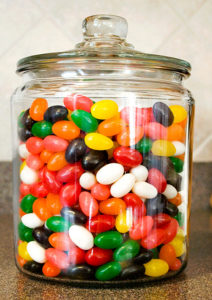Why learn to make calculations with whole numbers?
Rosemary is planning a birthday party for her daughter, Jacquelyn, who’s turning twelve. Jacquelyn has made two requests for her party: lots of candy, and no “little kid games” like pin the tail on the donkey. But Rosemary wants to incorporate an activity to keep Jacquelyn’s party guests entertained, so she suggests a candy-related game. She fills a glass jar with jelly beans and asks each party guest for their best guess on the number of jelly beans inside the jar. Whoever guesses the closest number gets to take the whole jar home!

On the day of the party, the jelly bean guessing game is a big hit. Rosemary notices that the kids use a few different strategies when coming up with their guesses:
- Ryan painstakingly tries to count all the visible jelly beans in the jar, and then he adds a few more to his guess to account for the ones he can’t see.
- Sarah gives the jar a good shake before guessing a random large number.
- Alisha picks up the jar, closes her eyes, and rolls it around in her hands a few times before writing down her guess.
- Johnny counts the pink ones he can see and then multiplies that number by the number of different jelly bean colors in the jar.
Jacquelyn helped her mom count the jelly beans before the party, so she enjoys watching her friends come up with their best guesses. But are any of her friends’ methods an accurate way to estimate how many jelly beans are in the jar? If you were a guest at the party, how would you come up with your guess?
While there are lots of different strategies you could use in a game like this, an understanding of whole numbers can help you come up with a quick and reasonable estimate. Let’s explore whole numbers before we find out who won the game.
